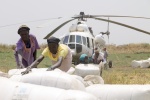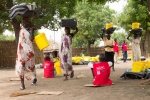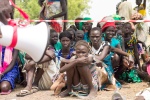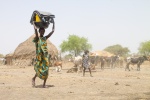For those who want to read quick and efficient; please go directly to the last paragraph.
For the others, enjoy the reading towards the last paragraph.

Vulnerable households are those who had to flee their own village because of fighting. They walked for days with a few items they could carry and had to find a new secure place to live. Vulnerable households are households where a pregnant women is leading a family with 8 children and possessing only one small cooking pot and a tiny jerry can. Vulnerable households are elderly people who don’t have family left and need to take care of themselves while they are prone to sickness.
Being vulnerable in the humanitarian context means that life circumstances are impacting your ability to have equal access to human rights. Your capacity is diminished to anticipate, cope, resist and recover from natural or man-made disaster or conflict.
People differ how they are exposed to risks as a result of their social group, gender, identity, age etc. With our work we are looking which people are in need the most. Even if the entire population is affected, we need to make this focus on the most vulnerable to be able to have the highest impact with the work we are doing. And since it takes time and resources to reach everyone, prioritisation is also needed. So we are aiming for the biggest impact, in the shortest time with the fewest resources.

I have struggled with this a lot. How can you prioritise a need? Is one need more important than another? And does this mean that someone deserves help more than another? How can you prioritise who to support, where to support, when to support and what type of support to give? Because if you decide that there is most need in place A, it means you can’t be in place B at the same time. So people in place B will still struggle to survive. I find this difficult and painful to accept.
Someone said to me that prioritisation of the needs can be compared with a triage in medical emergencies and disasters. The triage is used to determine the priority of the patient’s treatment based on the severity of their condition. An example is the wounded people in a battlefield; they are assessed by a doctor and labelled in 3 different categories. The labels indicate the patient’s need for medical treatment and transport from the battlefield. The three categories prioritise which people to treat immediate, before others, to save the most lives:
-

Woman is walking back home after receiving the items. Category 1. There are those who are likely to live, regardless of what care they receive. These are the people who are less affected, or who had the right capacities to cope with the disaster themselves. Maybe they still need help later because they don’t have all the human rights, but there is no direct life-threat.
- Category 2. There are those who are unlikely to live, regardless of what care they receive. They are either already dead or beyond help. Of course this is tragic, but it is a waste to spend time and resources on them.
- Category 3. There are those for whom immediate care might make a positive difference in outcome. This is obviously the group of people where you can have an immediate life-saving impact. Those are the vulnerable people who are in need the most, the group we try to aim for.
If it is put like this, prioritising needs sounds very helpful and logically as well. Still I will not be able to go to place B at the same time as place A. But even when that one drop of water falls precisely in your mouth, it does provide relief. That is where I am holding unto. There is still hope.
We recently did a distribution where we tried to reach the most vulnerable households in a remote village. The distributed kits with items included blankets, cooking pots, a bucket, hygiene items and fishing tools. An impression of this intervention can be seen below. I am sure that the distributed items supports the households to recover from their circumstances, which will impact their life immediately.

Having a big impact. Doing things quickly but efficient. No waste of money. Always busy and having no time. Goal oriented. It sounds like a familiar Western thought…
So let me give you one word of advice: If you are on your way to reach your goal while you are juggling five other balls around, please don’t forget to meet the people along your way. Look around and spend time to truly see the other. That is what I am trying to do as well.
I hope I can make the right decisions how to prioritize the needs. But while I am running to the big crowd who are in need the most, I will still open my eyes and stop when I am seeing someone sitting along the road. This is giving me unexpected surprises, true connection and a more purpose-driven life!
Disclaimer: The views expressed on this blog are solely ours and should not be taken, in any way, to reflect the official opinion of any organisation.














Wauw wederom respect! Wat mooi verwoord ook. Be blessed
x margreet en josephus
LikeLike
Het is moeilijk om keuzes te maken. Jullie proberen het goed en weloverwogen te doen. De foto’s maken mooi zichtbaar hoe gedisciplineerd de goederen worden verdeeld. Sterkte daar. Mooi dat je de mensen blijtt aankijken om contact te krijgen.
LikeLike
Nothing left to say. Zo trots op jullie! Blijf zo sterk en pas goed op jezelf! ❤
LikeLike
Bedankt voor weer een informatieve en persoonlijke blog. Hou vol daar!
LikeLike
Ha daar,
Wij hebben gemakkelijk praten hier, de commentaren die je soms hoort, vooral van mensen die het fijn vinden om een mening te hebben over van alles en nog wat, over hoe hulp geld nooit goed besteed wordt… dank voor het delen van de dilemma’s die je tegenkomt. Veel wijsheid gewenst. Hester
LikeLike